Ever thought about hiking on a massive river of ice that’s been around for hundreds, maybe even thousands of years? Well, that’s exactly what glacier hiking is all about. Picture yourself walking across an ancient, frozen landscape, surrounded by awe-inspiring views that most people only see in photographs. This is the unforgettable experience of glacier hiking.
When you’re out there on the glacier, everything else fades away. It’s just you, your ice axe, crampons, and the crunch of ice beneath your boots. The air is crisp and fresh, the silence profound, punctuated only by the occasional distant crack as the glacier shifts. Above you, snow-capped peaks rise against a crystal-clear sky, and all around are the stunning hues of the ice, a spectacle of blues and whites that seems to belong to another world.
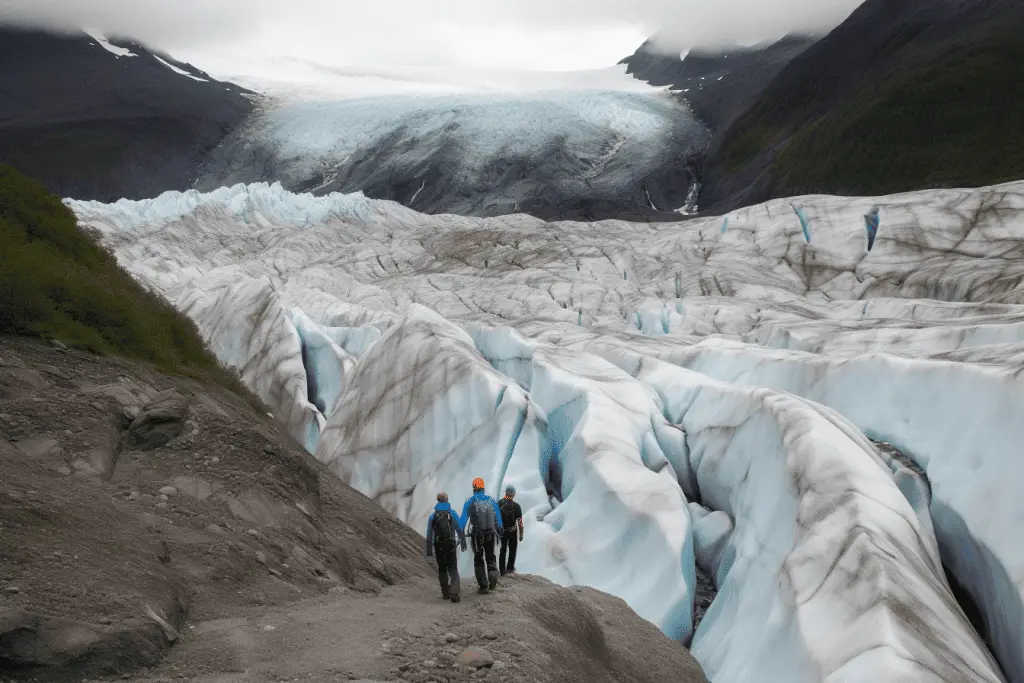
And that’s not even the best part. As you navigate crevasses, ice caves and seracs, there’s an incredible sense of accomplishment and adventure. It’s not just about the physical journey, but also the emotional and mental one. Glacier hiking challenges you, changes you, and offers perspectives you won’t find anywhere else. The memories you make here will truly last a lifetime. That’s the magic of glacier hiking, and it’s something you have to experience to truly understand.
What Is Glacier Hiking?
Glacier hiking, or ‘glacier trekking’ as it’s sometimes known, is essentially a hike on a glacier. Simple, right? But hold on, it’s not just a walk in a very cold park. Glaciers are dynamic and ever-changing landscapes of ice and snow, formed over many centuries as snowfall accumulates and compresses into dense ice. They’re constantly on the move, albeit very slowly, sculpting the land beneath them and creating unique formations like crevasses, moulins, and seracs.
Unlike regular hiking, glacier hiking requires special gear – think crampons for grip on the ice, an ice axe for stability and safety, and a harness and rope for tackling crevasses. And because glaciers can be hazardous environments, it also demands a guide or a good deal of experience and knowledge on your part.
But don’t let that intimidate you. The beauty of glacier hiking lies in its uniqueness and the extraordinary views you’re rewarded with. You’ll be trekking across a landscape that’s quite literally from another era, a relic of the last Ice Age, and you’ll be seeing firsthand the powerful impact these icy giants have on our planet.
So, in essence, glacier hiking is a lot more than a chilly stroll. It’s a journey back in time, a testament to the power of nature, and one of the most unique and exhilarating experiences you can have in the great outdoors.
Why Go Glacier Hiking?
First up, it’s all about the views. On a glacier, you’re not just looking at a stunning landscape—you’re part of it. Glaciers often reside in some of the most breathtaking environments on earth, nestled among towering mountain ranges or sprawling across vast valleys. There’s something absolutely surreal about walking on an icy expanse under a sky so blue it seems unreal, with the surrounding peaks reflected in the smooth, icy surface beneath you.
Next, it’s the thrill of adventure. Navigating a glacier requires careful attention, and the sense of accomplishment that comes with successfully traversing these icy landscapes is second to none. Each step on the crunchy, glistening surface, each crevasse crossed, and each challenging incline conquered adds to the excitement and achievement.
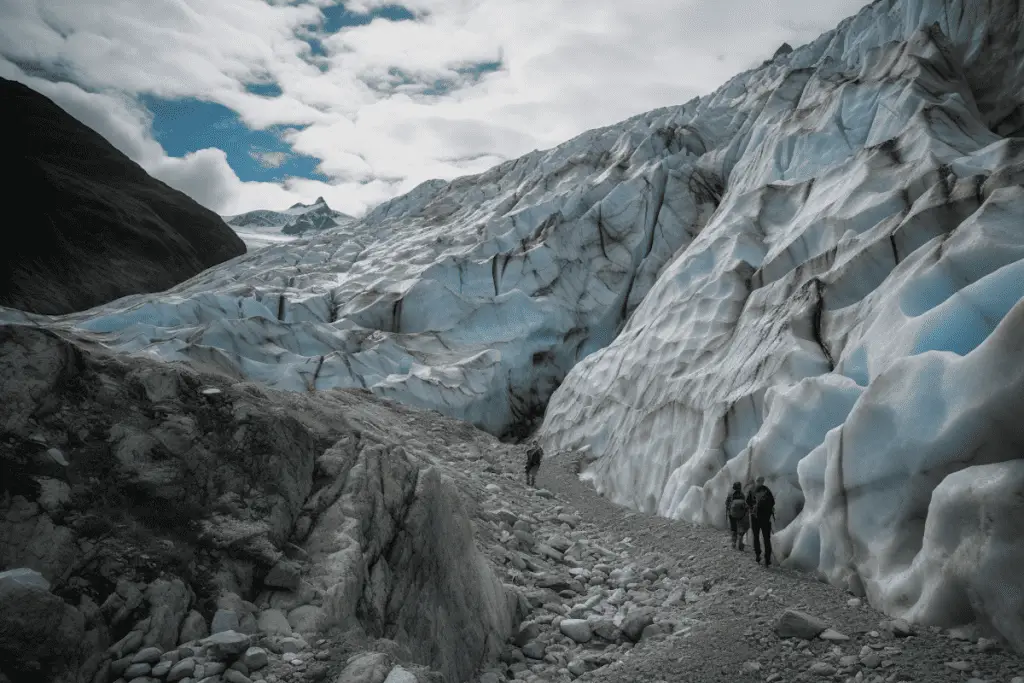
Thirdly, it’s the sense of connection. Glacier hiking connects you to our planet’s past, present, and future in a very direct way. As you explore these slowly flowing rivers of ice, you’re experiencing a direct, tangible link to our world’s climate history and getting a front-row seat to the realities of climate change.
Finally, it’s the bragging rights. Not everyone can say they’ve hiked on a glacier. Doing so puts you in a unique club of adventurers who’ve taken their love for the great outdoors to the next level.
So, why go glacier hiking? Glacier hiking is one of the most unique, exciting, and eye-opening adventures you can have. You’ll challenge yourself, be rewarded with breathtaking views, and develop a deeper connection to our incredible planet. That’s the unique allure of glacier hiking.
Where To Go Glacier Hiking: Top Destinations Around The World
If you’re now sold on the idea of glacier hiking and itching to hit the ice, you’re probably wondering where you should go. Luckily, our planet is rich with glaciers that offer excellent hiking opportunities. Let’s look at some top picks from around the globe.
Let’s start with the mecca of glacier hiking – Iceland. The country’s name might be a bit misleading (it’s actually quite green), but it’s home to some incredible glaciers. One of the most popular is Vatnajökull, Europe’s largest glacier. Here you can explore ice caves, trek across the icy expanse, and take in the extraordinary scenery.
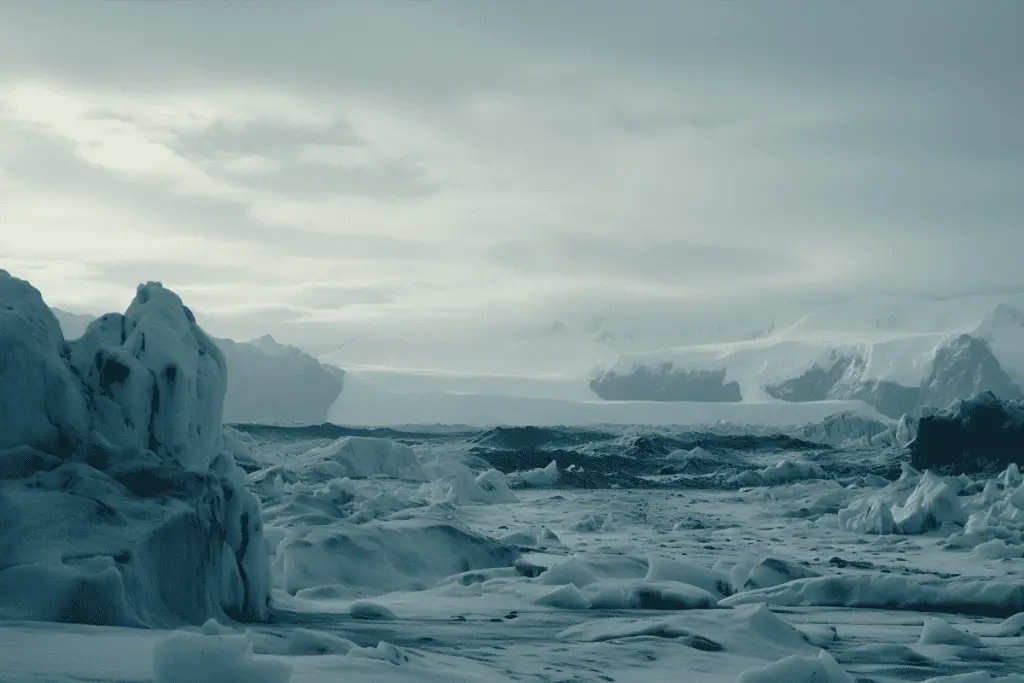
Next up, let’s hop over to New Zealand’s South Island, where you’ll find the famous Fox and Franz Josef Glaciers. These glaciers are unique because they descend from the peaks of the Southern Alps right down into a temperate rainforest. Now, that’s not something you see every day!
Over in Europe, the Mer de Glace in the French Alps is a must-visit. It’s France’s largest glacier and offers fantastic hiking opportunities, along with the chance to descend into an ice grotto.
The Perito Moreno Glacier in Argentina’s Patagonia is another stunning destination. It’s one of the few advancing glaciers in the world, and the thunderous spectacle of ice calving from its face into the turquoise waters below is something you’ll never forget.
Lastly, the Harding Icefield in Alaska, USA, offers an incredible hike. With almost 40 glaciers flowing out from the ice field, the trail offers one awe-inspiring view after another.
Each of these destinations offers its own unique glacier hiking experience, so your choice will depend on what kind of adventure you’re looking for.
How To Go Glacier Hiking: Step by Step
So, you’ve got your destination picked out, your bags are packed, and you’re ready for some icy adventure. But what exactly does the glacier hiking process entail? Well, let’s walk through it step by step.
First and foremost, safety is key. It’s crucial to hire a guide if you’re not an experienced glacier hiker. These pros know the terrain, the conditions, and the safety procedures like the back of their hand. Most glacier hikes start with a safety briefing, where your guide will familiarize you with the equipment you’ll be using, like ice axes, crampons, and ropes, and discuss important safety measures.
Next, you’re likely to set off on a trek to reach the glacier itself. This could involve a straightforward hike, a boat ride, a helicopter flight, or even a small climb, depending on the location of your glacier. It’s a fantastic warm-up and often takes you through some stunning landscapes.
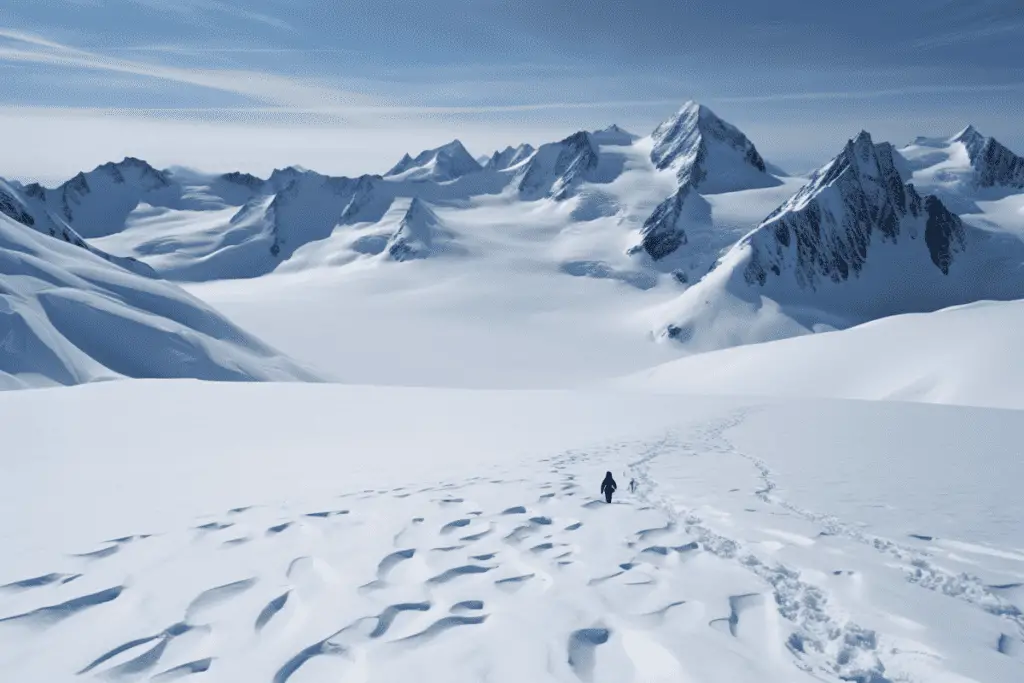
Once you’ve reached the glacier, it’s time to strap on your crampons and get hiking. You’ll traverse the icy landscape, navigating around crevasses, climbing small ice walls, and maybe even exploring ice caves. Your guide will lead the way, cutting into the ice with an axe to create steps if necessary, and always making sure you’re safe and comfortable.
Along the way, don’t forget to soak in the views and take plenty of photos. The beauty of glacier landscapes is truly extraordinary. And remember to take a moment to appreciate the grandeur of the glacier itself, a relic of a bygone era slowly but surely on the move.
Essential Gear for Glacier Hiking
First up, let’s talk about what you’ll be wearing on your feet. You’ll need sturdy hiking boots that can accommodate crampons. Crampons, those spiky attachments you see on ice climbers’ boots, are crucial for maintaining traction on the icy glacier surface. And don’t worry if you don’t own a pair – they are often provided by tour operators or can be rented from outdoor outfitters.
Next up is an ice axe. It serves as your third point of contact with the ground (in addition to your two feet) and can be used for stability and to arrest a fall if you slip on the ice. Like crampons, this is often included with guided hikes.
A harness and rope are other key pieces of gear. In some cases, your guide might have you roped up together for safety, particularly in areas where crevasses – those deep cracks in the ice – might be concealed.
For your clothing, think layers. The weather can change quickly on a glacier, and you’ll want to be able to adjust your attire accordingly. Start with a moisture-wicking base layer, add an insulating middle layer (like a fleece jacket), and top it off with a waterproof and windproof outer layer.
Don’t forget a hat and gloves to protect against the cold, and a pair of sunglasses is a must to shield your eyes from the glare off the ice. And lastly, pack a good sunscreen – sunburns can happen even in the coldest environments due to the sun reflecting off the snow and ice.
Remember, while the gear might seem overwhelming, having the right equipment is key to a safe and enjoyable glacier hiking experience. And once you’re geared up and out on the ice, you’ll be too busy being wowed by the views to worry about what you’re wearing!
Preparing Physically and Mentally for Your Glacier Hike
Glacier hiking is an adventure like no other, but it’s not a casual stroll in the park. It requires a good level of physical fitness and a certain mental preparedness. But with a little preparation, you can make sure you’re ready to fully enjoy the experience.
Physically, you should be in shape for a long, active day. While the exact demands will depend on the specific glacier and route, expect several hours of hiking, often on uneven terrain. Cardiovascular exercises like running, cycling, or swimming can help build your stamina. Strength training, particularly for your legs and core, can also be beneficial. And don’t forget flexibility – exercises like yoga or pilates can help you avoid injury during your hike.
But it’s not just about physical fitness. Being mentally prepared for your glacier hike is equally important. You’re going to be in a unique, and sometimes challenging, environment. There might be periods of strenuous activity, cold conditions, and perhaps a little bit of fear if you’re new to this kind of adventure.
Preparing mentally means understanding what you’re getting into. Take the time to learn about glacier environments and the specific challenges you might face. Be ready for the fact that you might need to push through some discomfort or fear. And remember that it’s OK to take things at your own pace. This is your adventure, after all!
Remember, the goal isn’t just to endure your glacier hike – it’s to enjoy it. Proper physical and mental preparation can help you do just that. Take the time to prepare, respect the glacier, and embrace the adventure. You’ll come away with an experience you’ll never forget.
Safety First: Navigating Risks and Hazards
When it comes to glacier hiking, the old saying “safety first” has never been more true. Glaciers are stunning and awe-inspiring, but they can also be dangerous if not treated with respect. Here’s what you need to know to stay safe on the ice.
Firstly, the single most important thing you can do is hire a guide unless you’re an experienced glacier hiker yourself. Glaciers are complex and ever-changing, and hazards like crevasses or unstable ice can be difficult to spot if you’re not familiar with them. A good guide will know the glacier well and be able to lead you safely along the best route.
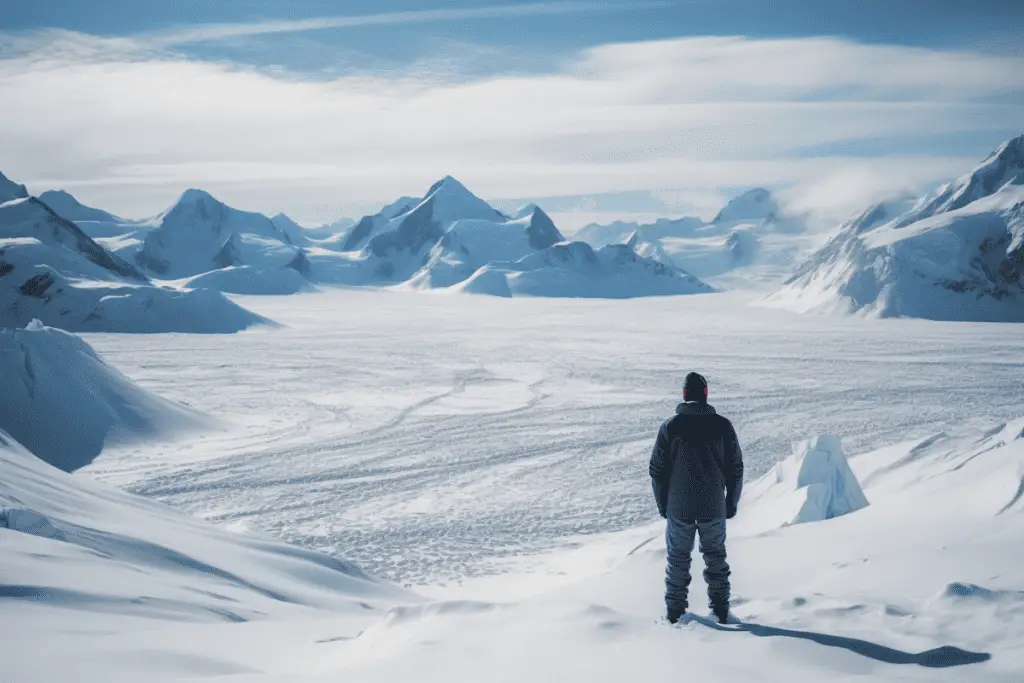
That said, it’s also important to understand the potential risks yourself. Crevasses – those deep cracks that can open up in the ice – are a major hazard on many glaciers. Always stay roped to your guide or team when crossing areas with crevasse danger, and never wander off on your own.
Falling ice is another risk to be aware of, particularly if you’re near the edges of the glacier or under seracs, those towering blocks of ice that can form on steep glaciers. Again, a good guide will help you navigate these hazards.
Weather can also be a major safety factor. Conditions can change rapidly on a glacier, turning a sunny day into a whiteout in no time. Always check the forecast before heading out, and be prepared with suitable clothing and gear.
Finally, remember that glacier hiking can be physically demanding. Make sure you’re in good health, and don’t push yourself beyond your limits. Stay hydrated, take breaks when you need to, and always let your guide know if you’re feeling tired or unwell.
Glacier hiking is an amazing adventure, but it’s not without its risks. With knowledge, preparation, and a healthy respect for the power of nature, you can ensure your trip is a safe and enjoyable one. After all, the aim is to create unforgettable memories, not unwanted mishaps!
Glacier Hiking Tips
Ready to head out? Here are the 5 most important glacier hiking tips I can think of:
- Hire a Guide: If you’re not experienced in glacier hiking, hiring a professional guide is essential. Guides are experts in navigating the unique and dynamic environment of a glacier and will ensure your safety while providing a wealth of knowledge.
- Prepare Physically and Mentally: Glacier hiking can be physically demanding, so it’s crucial to get in shape beforehand with a mix of cardio and strength training. Also, prepare yourself mentally for the challenges and keep a positive mindset to fully enjoy the experience.
- Gear Up Right: Ensure you have the appropriate gear for glacier hiking, including sturdy, crampon-compatible boots, an ice axe, a harness, ropes, and layered clothing to adapt to changing weather conditions. Don’t forget sun protection and hydration, too.
- Understand the Weather: Weather in glacier regions can change rapidly, turning a sunny day into a challenging situation quickly. Check the forecast before your hike, understand signs of changing weather, and be prepared to turn back or seek shelter if conditions worsen.
- Safety is Paramount: Always prioritize safety. Stay alert, follow your guide’s instructions, and never stray from your group. Understand the potential risks of glacier hiking and how to react in case of emergencies. A safety briefing is crucial before setting off on your adventure.
Final Thoughts
And there you have it – your comprehensive guide to glacier hiking. From understanding what this incredible adventure entails, to choosing your destination, prepping the right gear, and brushing up on important safety measures, you’re now equipped with the knowledge you need to embark on this icy escapade.
Remember, glacier hiking is about more than the physical journey. It’s about immersing yourself in the raw beauty of nature, respecting the powerful forces at play, and connecting with our planet in a truly unique way. So, lace up your boots, gather your courage, and prepare to step out onto the ice for an experience like no other.
